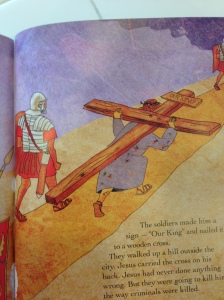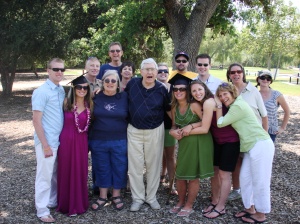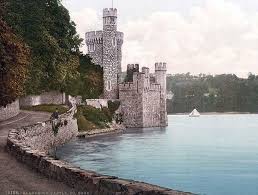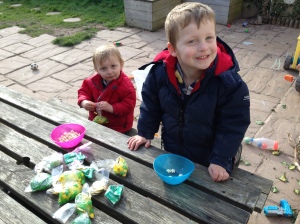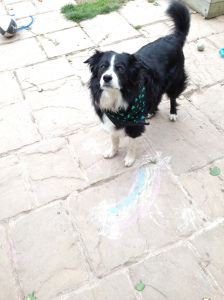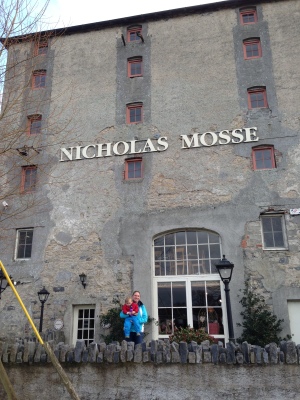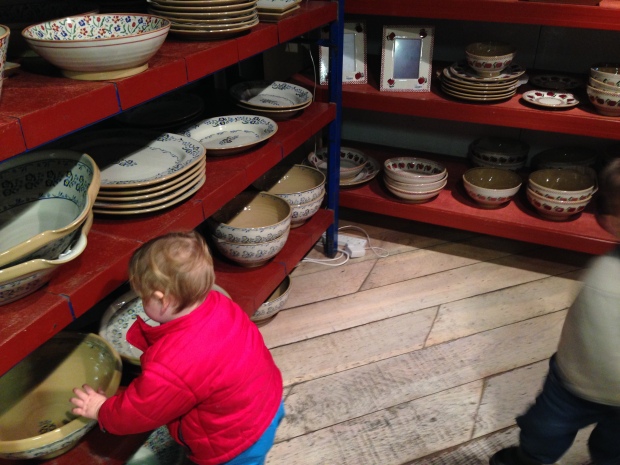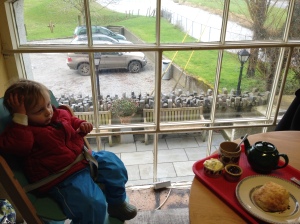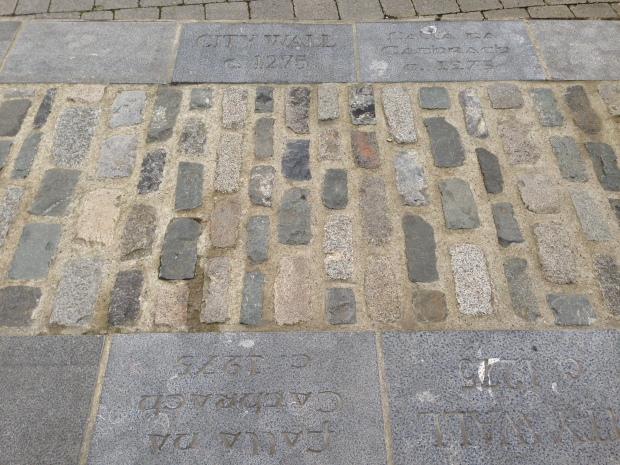This weekend we took a roadtrip to a foreign country: Northern Ireland. Yes, this is still part of the island of Ireland and, no, there is not a physical border crossing that you pass through (much to my disappointment…I really wanted another stamp in my passport!). Nevertheless, The North is part of the U.K. and is, therefore, a separate country. Our destination this weekend was Belfast, a city rich in history and conflict. A city, we happily discovered, that is well worth a visit. When we told David that we were going to Belfast, he quickly retorted that he wanted to see “ships and sheep” there (not sure why…guess he just thought that would be cool to see). So, we had our mission set before us: get to Belfast and see ships and sheep.
The drive from Cork to Belfast is just over 4 hours. We loaded up our car with snacks and iPads for the kiddos and left town early Friday morning. We made one stop along the way, just north of Dublin. The Gas Station Oasis (as I’m now referring to it) that we stopped at was amazing–it had shops, restaurants, free wifi, and indoor and outdoor playgrounds for the kids. It was the perfect place to stop, refuel, and get some wiggles out before getting back on the road.

Our journey went smoothly and both kids did great during the long drive. We arrived in Belfast at about 2:00, and that’s when the most stressful part of our trip began. First, we missed a turn and got onto a Motorway going the opposite direction of where we needed to be. Ordinarily this wouldn’t be such a big deal but, since we were now in a foreign country, our cell phones weren’t working yet with the local network. Which means that the GPS we were using for navigation went out. And the physical maps we had were not detailed enough for us to find our way out. Which means we were a bit lost. In the end, Jon’s keen sense of direction got us back on track and we found our destination–a bit frazzled and a bit later than we had hoped to arrive, but all in one piece. And that leads me to our next problem.

Jon had a Very Important Meeting that he had to attend for work that afternoon at 3:00 (so the driving aimlessly around lost in a city we’ve never been to before really didn’t help things). We had originally thought we could check in to our accommodations in time for the Very Important Meeting so Jon could use the wifi. Unfortunately, our host was out of town until later in the evening and we couldn’t be let in until he got back. Long story short, we found a business center just in the nick of time that Jon could go in and pay (a lot of money) to have a conference room so he could use the wifi and take his phone call for the Very Important Meeting.
Unfortunately for me, I was now stranded in a city I’d never been to before, without a car or navigation, with two hungry and very tired children. I didn’t quite know what to do with myself, so I just started walking toward the big buildings that I assumed represented downtown. Thankfully my instincts were right and we quickly found our way to the central train station. We hunkered down at the train station for awhile so we could eat a snack and get our bearings.

There were lots of maps available at the train station so I picked one up and we headed back out to explore the city. Belfast is a beautiful city. Most of the buildings were built of brick in the mid-1800’s, so everywhere you look there are these rich red-brown buildings towering over you:
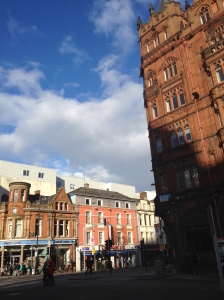
After wandering around the city for awhile we found our way to the waterfront where we watched boats cruising up and down the river (and where the boys could participate in their favorite activity of all time, throwing rocks into water).
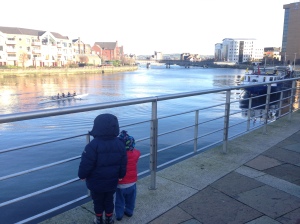
Finally, the Very Important Meeting was over and our host was available to let us in to our house. For me, the house we stayed in was actually one of the coolest parts of our trip. The house was originally owned by Anthony “Artie” Frost. Artie was an engineer for Harland and Wolff, the company responsible for building Titanic right here in Belfast. Artie was a member of the Titanic Guarantee Group, which basically means that Harland and Wolff were so sure their ship was unsinkable that they sent a team of their own engineers to ride on its maiden voyage as a “guarantee” of how sound she was. Artie perished in the sinking of Titanic, leaving behind a wife and three children (and, consequently, his very cool house):

As we were walking around Belfast we came upon this Titanic memorial at City Hall. On the base of it there is listed every Belfast resident who lost their life on Titanic:

And right there, 4th name from the top, is our friend Anthony Frost:

The house was quite spacious. The boys each had their own room on the 3rd floor, we had the master suite on the 2nd floor, and the living space was on the 1st floor. David and Jacob loved all of the stairs and they had races to see who could slide from the top floor down to the bottom the fastest:

The view from the landing between the 2nd and 3rd floors of the house was pretty amazing. The house backs up to a church and, if you look into the distance, you can see the yellow gantry cranes of Harland and Wolff that still stand at the same shipyard where Titanic was built. I can just imagine Artie Frost standing here in his house and looking out this window to see the building of this unsinkable ship he had helped to design:

After we got settled in that night we walked around the neighborhood and found a great little pizzeria for dinner. We were all pretty wiped out from our big day of travel so we just got our pizza to go and brought it back to the house to eat. And then, it was off to sleepy-land for all of us.

The next morning (Saturday) we started our day in a neighborhood right down the street from where we were staying. Jon and I really wanted to come here because this is where one of our favorite authors, C.S. Lewis, got his start. C.S. Lewis holds a special place in our hearts because Jon and I actually met when we were in college studying one of his books together. We just had to see where the beginning of our beginning was.

C.S. Lewis was born in this house, “Little Lea”, in 1898. He lived in this house until he joined the service during World War I when he was 19 years old:

We couldn’t actually go inside the house because it is a private residence, but it was still fun to see it and picture where little C.S. (well, they called him Jack back then) used to roam. C.S. Lewis told his biographer that he used to spend hours upon hours playing in an upstairs room in this house when he was a boy–an empty room with nothing but a wardrobe–and that this was his inspiration for “The Lion, The Witch and The Wardrobe”. Here is a photo that I found in a book in a library in Belfast of C.S. Lewis with his family standing on the front porch of Little Lea when he was a boy (C.S. Lewis is second from the left in this photo, wearing the black outfit):

After our walk around C.S. Lewis-land we drove into the city for some exploring. We started at Victoria Square, a large shopping center in the heart of the city center. We got some coffee and then made the obligatory stop at the Belfast Apple store. Then we took the lift to the dome at the top of the shopping center where there were some amazing views of the city:
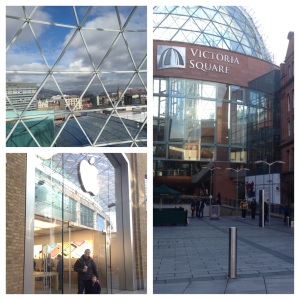
Our shopping spree continued down the road at St. George’s Market, the oldest public market in Belfast. The market has a very interesting history that is shown in a series of photos that line the walls of the market. Apparently, during the Belfast Blitz of World War II this space was even used as a temporary mortuary to house the bodies of those who perished in the attack.
The Saturday morning market was buzzing with vendors selling everything from produce to meats to spices, baked goods, preserves, artwork, handicrafts, and toys. David got a new stuffed animal there, a hippo that he has named “David Junior”. As an added bonus, the boys also got to pet goats, rabbits, and baby chicks:
From the market we continued on to the Linen Hall Library, the oldest library in Belfast. Books were quite a rarity in Ireland when this library was built in 1788, so it was quite a landmark for its day. The library had a nice children’s area where the boys could play and read, and there was an amazing collection of Irish works on the top floor (including several written by and about our favorite Belfast-born author, C.S. Lewis):

We spent our afternoon exploring the Titanic Belfast museum. The museum opened about 2 years ago, just in time for the 100th anniversary of the sinking of Titanic. It is a beautiful modern museum with incredible exhibits. The museum is in the dock area of Belfast, on the actual site where Titanic was built in the early 1900’s. The building is even meant to resemble the shape and size of Titanic, so you really get a good idea of how massive the ship would have been:

We spent several hours exploring the museum. There were lots of interactive exhibits that could engage even the fidgety-est of 3-year olds:

There was even a ride in the museum that took you through the ship-building process. We got to ride in our own little pod that was suspended from the ceiling, almost like a gondola that went up and down and all around. It was hard to get a good photo on the ride because it was dark and moving, but we all had a great time!

Wandering through the museum we even came across several places where “our” former house-owner, Anthony Frost, was mentioned:

After seeing the entire Titanic Museum we decided to continue on to view one more piece of Titanic history, the pump house and docks where Titanic was fitted out for sea. On our way to the docks we passed Titanic Studios, a production studio where the T.V. show “Game of Thrones” is filmed:

The Pump House (the area that housed machinery for pumping sea water in and out of the docks) was pretty much left exactly how it was in the early 1900’s when Titanic was housed outside its windows. There were lots of big levers and wheels and buttons that the boys could touch, and lots of loud gangways that they could run (er…walk…) up and down:

The docks themselves were amazing. Just this huge, huge pit in the ground where enormous ships would have sat until they were ready for sea. This photo shows Titanic sitting in the dock, with the empty dock behind it:

We were able to go all the way to the bottom of the dock and stand where the bottom of Titanic would have sat. Being in the massive dock with towering walls rising 4 stories above your head gives you an appreciation for the people who would have been down here working on the ship every day. Let’s just say I’m glad that wasn’t my job!

Suffice it to say, we saw lots of ships and “ship stuff” in Belfast. Alright, David, one down, one to go on the “ships and sheep tour”.
Our final excursion for the day was to drive by the “Peace Walls” that separate Catholic and Protestant neighborhoods in Belfast. During The Troubles that scarred this city for nearly 40 years, these walls were erected to keep peace between warring groups of Protestants and Catholics. Even though city officials have tried to take down the walls in recent years, the residents living inside them insist that they remain standing. Many of the walls are covered in colorful murals:

…and other sections of the walls just look like prison barriers, complete with barbed wire and police watch towers:

This house even has a cage covering their entire back yard–just in case someone tries to throw a petrol bomb or something over the fence:

It was crazy to see how some people in this city still live in fear–and even hatred–of their own neighbors.
The next day (Sunday) we made one more stop before heading out of town. We visited a unique “museum” called the Ulster Folk Park on the outskirts of Belfast city. The folk park consists of historical buildings from around Ulster (the region of Northern Ireland where Belfast is located) that have been relocated to the park. Each building was taken apart, stone-by-stone or brick-by-brick, and moved here to the park. The park is set up to look like a city and a rural community in Ulster during the early-1900’s. Guests can wander through the town, go inside the buildings, and even see actors dressed in period costume who demonstrate what life would have been like 100 years ago:

I enjoyed sitting the boys down in the 1-room school house–boy am I glad I never had to work in one of those! One teacher, up to 100 children aged 6-12, 1 coal-burning fireplace for heat, 1 outhouse, and very few books or learning materials available. At least the pupils were cute:

There were beautiful old farm houses that we could explore both outside:
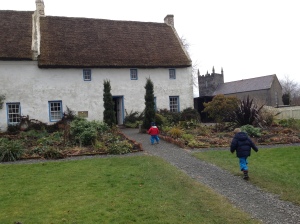
…and inside:

There was even a man demonstrating how a printing press works–we were all very impressed:

We found our way out to the “rural” part of the museum where there were working farms. We saw all sorts of animals, including donkeys, chickens, pigs, and SHEEP! Sheep: check.

Our last stop at the folk park was the town sweet shop so we could pick up some treats for the looooong drive back to Cork. David chose the largest, most ridiculously-colored rainbow lollipop in the store.

The folk park was huge–we were there for over 3 hours and we still didn’t see everything. Alas, it was time for us to say goodbye to Belfast and hit the road. We thoroughly enjoyed our weekend in Belfast, and we’d love to come back to Northern Ireland again soon to explore the Northern coast and surrounding areas. For now, though, I think we can leave saying that we saw all that we came to see–even ships and sheep.
 Start by preheating your oven to 350 degrees. While the oven is preheating, get out your Bible and open up to John 19 or find the Easter story in a children’s Bible (my favorite is the Jesus Storybook Bible). Below you’ll find the pictures and the “script” for how I told the story to David (he’s only 2 years old, so I kept it simple for him).
Start by preheating your oven to 350 degrees. While the oven is preheating, get out your Bible and open up to John 19 or find the Easter story in a children’s Bible (my favorite is the Jesus Storybook Bible). Below you’ll find the pictures and the “script” for how I told the story to David (he’s only 2 years old, so I kept it simple for him).

